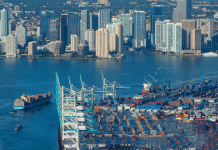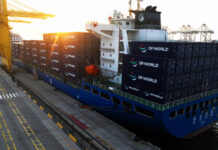Seventy-eight percent of container vessels visiting here last month cut engines and plugged into landside electrical power, the Port of Oakland reported on August 31, 2018. It was the highest plug-in rate ever recorded in Oakland. The Port said the performance demonstrates progress in its effort to curb diesel emissions from ships.
According to Port data, 105 of 135 vessels visiting Oakland in July connected to shoreside electricity at berth. The ships then switched off auxiliary diesel engines that typically power onboard systems during port stays. The result: tons of diesel particulate exhaust kept out of the skies over the city.
“We’ve been working with shipping lines for a long time to accelerate the rate of shore power adoption,” said Port of Oakland Maritime Director John Driscoll. “On behalf of all of us who breathe the air in Oakland, it’s gratifying to see this level of cooperation.”
State regulators require that container shipping lines frequently calling California ports plug in at least 70 percent of their vessels. The bar gets raised to 80 percent in 2020. Until last month, the Port’s best plug-in rate had been 76 percent of all vessels in July 2017.
Oakland has been working to boost shore power use since 2012. The Port attributed its progress to:
- Shipowners who spend about $1 million per vessel to retrofit vessels for shoreside plug-ins;
- Port technicians who commission ships for shore power;
- Harbor pilots who align 1,200-foot-long ships with shoreside electrical vaults while berthing;
- Longshore workers who connect ships to the grid via heavy cables.
Container ships are the biggest source of diesel exhaust at the Port. Diesel vessel emissions have declined 80 percent since 2005, thanks in large part to shore power and the use of cleaner-burning low sulfur fuel in ships.
The Port said it’s seeking more plug-ins to reach an 85 percent overall reduction in diesel emissions by 2020. The challenge is that some container ships aren’t yet equipped to plug-in, the Port said.





